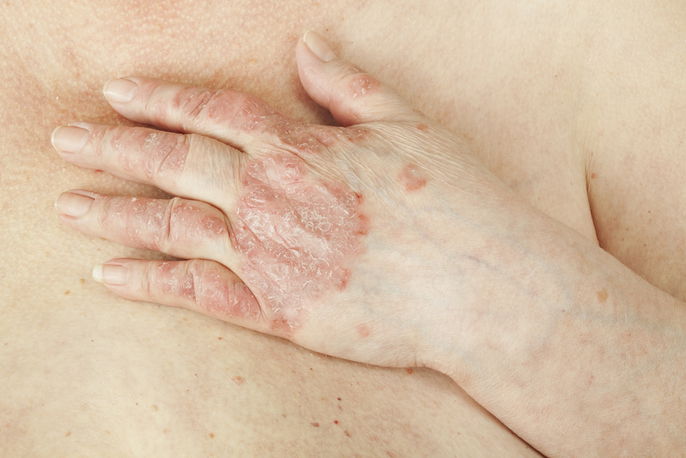What is it:
Psoriatic arthritis is a type of chronic arthritis that affects the joints of people with a history of psoriasis, a skin condition characterized by red, flaky patches of skin.
The main symptoms of psoriatic arthritis include joint swelling, visible joint deformity with difficulty moving them, as well as red skin patches.
Psoriatic arthritis can appear at any age, but it is most frequently diagnosed in adults between the ages of 30 and 50. About 30% of people with psoriasis develop psoriatic arthritis.

Main symptoms
The most common symptoms of psoriatic arthritis are:
- Joint swelling and deformity
- Pain and difficulty moving joints
- The presence of red, flaky patches on the skin, fingernails or scalp that are itchy
- Ocular, cardiac, pulmonary or renal changes
Many times, the first signs of this type of arthritis are difficulty moving the joints, especially the hands. Swelling or skin patches are not always necessarily present.
People who have psoriasis and present with joint problems should see a doctor for assessment, diagnosis and treatment.
Confirming a diagnosis
Diagnosis of psoriatic arthritis is normally confirmed through an evaluation of symptoms, assessment of the skin lesions, and an x-ray to confirm the presence of joint abnormalities.
The doctor may opt to order a rheumatoid factor blood test to rule out rheumatoid arthritis as a cause of your symptoms. If the rheumatoid factor is negative but arthritis-like symptoms are present, this may help to guide the doctor to the correct diagnosis. If the rheumatoid factor is positive, the symptoms are likely caused by rheumatoid arthritis and are not related to psoriasis.
Read more about the symptoms, causes and treatment of rheumatoid arthritis.
Types of psoriatic arthritis
There are 5 main types of psoriatic arthritis
- Symmetric: This type affects the joints on both sides of the body
- Asymmetric: With this type, symptoms are more mild and generally affect up to 4 joints anywhere in the body
- Psoriatic arthritis mutilans: This type is more aggressive and tends to destroy the joints in the hands and feet. It particularly affects the fingers.
- Psoriatic spondylitis: This type is characterized by neck and spinal rigidity.
- Distal interphalangeal predominant (DIP): This type is characterized by stiffness in fingers and toes. Some people also develop fingernail or toenail deformities.
A rheumatologist can help to identify the type of arthritis the patient has and can indicate the best treatment for each case.
Treatment options
There is still no cure for psoriasis, and therefore treatment is aimed at reducing and managing symptoms to prevent worsening.
One of the first approaches to treatment is making lifestyle changes that help to prevent risk factors for this condition, like obesity, hepertension and diabetes. Patients are also advised to quit smoking and avoid consuming other drugs, and to exercise regularly and eat a balanced diet.
Other treatment options include:
1. Anti-inflammatory medication
The main medications used for this condition are non-steroid anti-inflammatories, like ibuprofen or naproxen. These can help improve the signs and symptoms of this illness in the short term, which can help with relieving discomfort.
In more severe cases, or when treatment with anti-inflammatories are ineffective, other medications can be prescribed. Corticosteroids and medications like sulfasalazine, methotrexate and cyclosporine can help to slow the course of this progressive disease.
2. Surgery
Surgery for psoriatic arthritis is recommended when the illness is very aggressive and causes joint damage. The objective of surgery is to improve or replace damaged joints, and improve quality of life.
3. Physiotherapy
Physiotherapy is a very important aspect to treatment, as there are many exercises that can help improve joint movement, relieve associated symptoms of tendinitis and improve overall quality of life.
Treatment should involve a multi-disciplinary approach and should be guided by a medical team consisting of a rheumatologist, orthopedic surgeon, family doctor, physiotherapist, psychologist and any other health care professional who can improve quality of life.






























